Recent US-led coalition airstrikes in Iraq and Syria have resulted in a sudden escalation in civilian casualties. On 16 March, a US airstrike designed to root out Al-Qaeda militants hit a mosque in Al Jinah, a village situated between the Syrian cities of Idlib and Aleppo, and killed 42 people. The next day, an airstrike on the al-Jadida neighbourhood in Mosul was reported to have killed over 200 people – making it one of the US’ deadliest airstrikes in the region since the Iraq invasion in 2003. On 21 March, an airstrike targeted a school sheltering at least 30 civilians in Raqqa province.
These incidents are only the few mentioned in the international media. Airwars, a non-profit group monitoring civilian death rates from airstrikes in Iraq and Syria, have estimated over 1000 deaths in March from coalition airstrikes. This reveals an increasingly concerning pattern of an indiscriminate use of force against innocent civilians in the struggle to root out terrorists in the region.
However, in the case of Mosul, a narrative appears to be emerging which attributes the civilian casualties to ISIS militants using civilians as human shields. US Defense Secretary James Mattis has said: ‘…an enemy hides behind women and children…and we go out of our way to always do everything humanly possible to reduce the loss of life or injury among innocent people.’ News sources also report that the day of the airstrike, witnesses saw ISIS fighters firing from the rooftops of buildings they knew were inhabited by civilians either to shield themselves from return fire or to ‘bait’ coalition and Iraqi forces into responding, thereby ruining the reputation of the coalition and Iraq government. One survivor reports how ISIS fighters initially entered their home and left just before the airstrike hit; the airstrike resulted in the death and injury of family members but left the ISIS fighters alive.
While casualties may very well be attributed to ISIS tactics, the narrative that Mattis perpetuates follows a tradition of justification by political and military leaders that care is always taken to prevent civilian casualties, and that any casualties that do occur are always due to the enemy. For years, ISIS has been known to use human shields, so military forces should be taking better account of that strategy to avoid playing into ISIS’ hands rather than using it as a base for a ‘we are good’ and ‘they are evil’ narrative when airstrikes go wrong.
The narrative is further bolstered by normalization of the situation. Iraq’s special forces commander, Maj. Gen. Maan al-Saadi, commented that the airstrike in Mosul was ‘an unfortunate outcome’ and that civilian deaths ‘in return for liberating the entire city of Mosul — I think it is a normal thing.’ As the nature of the conflict has begun to change with coalition and Iraqi forces moving away from fighting in remote, sparsely-populated areas towards densely-populated, labyrinthine cities, avoiding civilian death entirely is near-impossible. However, to normalize the situation and refocus the narrative solely on the ‘enemy’ is problematic and allows governments to perceive themselves as winning a war, even as they overlook those who suffer the most for their victories.
Human rights groups are growing increasingly concerned that the coalition isn’t doing enough to protect civilians, and the current narrative which primarily focuses on ISIS’ actions risks ignoring how coalition and Iraqi forces have also played a part in high casualties. In Mosul, both ISIS fighters and Iraqi forces have opened fire in close quarters, with indiscriminate mortar-fire being launched within the city and ISIS militants retaliating with suicide car bombs. Prior to the airstrike, Amnesty International reported that civilians were told by Iraqi authorities to remain in their homes during the offensive to retake Mosul from ISIS rather than to evacuate. Another Mosul survivor who recalled seeing only a few ISIS militants on some of the buildings, questioned ‘Why, just because of one Daesh, kill everyone?’
There are also suspected changes to US procedure for carrying out airstrikes, as evidenced by earlier changes to Yemen military operations to ease battlefield rules. Human Rights Watch (HRW) reports that since December 2016, the US has lessened the steps required for the authorization and clearance of coalition airstrikes. A ‘strike cell’ in Baghdad is usually responsible for communicating information about target areas, confirming enemy presence, and providing recommendations before authorizing strikes; however now, airstrikes may be carried out without additional authorization and intelligence from the ‘strike cell’. This may have contributed further to the high casualties in Mosul as Iraqi forces claimed no prior knowledge of civilians in the area, while noting airstrikes are easier to call in now since the procedural changes.
While the incident in Mosul is currently under investigation by the US and Iraq, HRW has observed a lack of transparency to the investigation. In the days following the attack, officials investigating the site attributed the deaths to an internal explosion from packed ISIS bombs rather than airstrikes, denying witness and survivor reports that it was airstrikes and blocking external organizations and journalists from accessing the area. This again, feeds further into the narrative that ISIS is entirely to blame, while US, coalition, and Iraqi forces are absolved of taking responsibility and being held accountable for the part they have played in exacerbating human rights violations.
The airstrikes have consequences in international humanitarian law as disproportionate and indiscriminate attacks, and international failure to provide adequate civilian protection and to minimize civilian harm essentially constitutes war crimes. Attempting to reframe and hide behind a narrative that the airstrikes have been manipulated for enemy use, even while denouncing Russia and Syria for their own actions in the conflict, does not mean accountability should be forgone. As the conflict intensifies, accountability needs to be at the forefront as a way to get coalition and Iraqi forces to consider alternative methods of warfare such as increased support for ground troop operations and strategies, and bolstering civilian protections.
Photo: Field hospital in Mosul, Northern Iraq (2016), by Mstyslav Chernov via Wikimedia Commons. Licensed under CC BY-SA 4.0.
Disclaimer: Any views or opinions expressed in articles are solely those of the authors and do not necessarily represent the views of the NATO Association of Canada.




